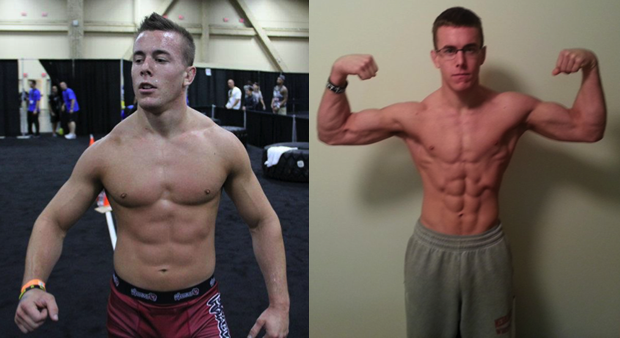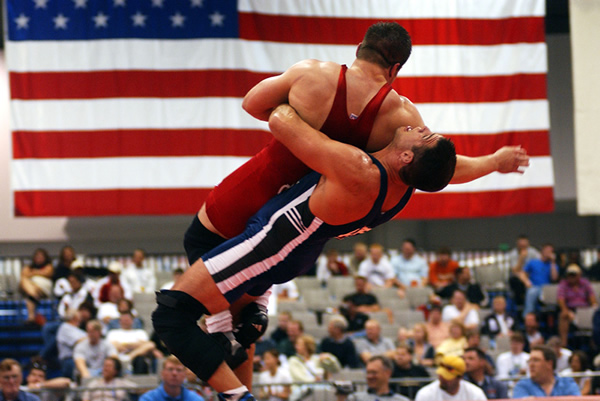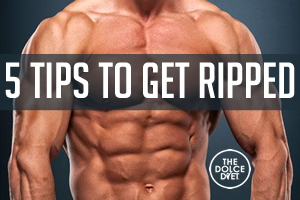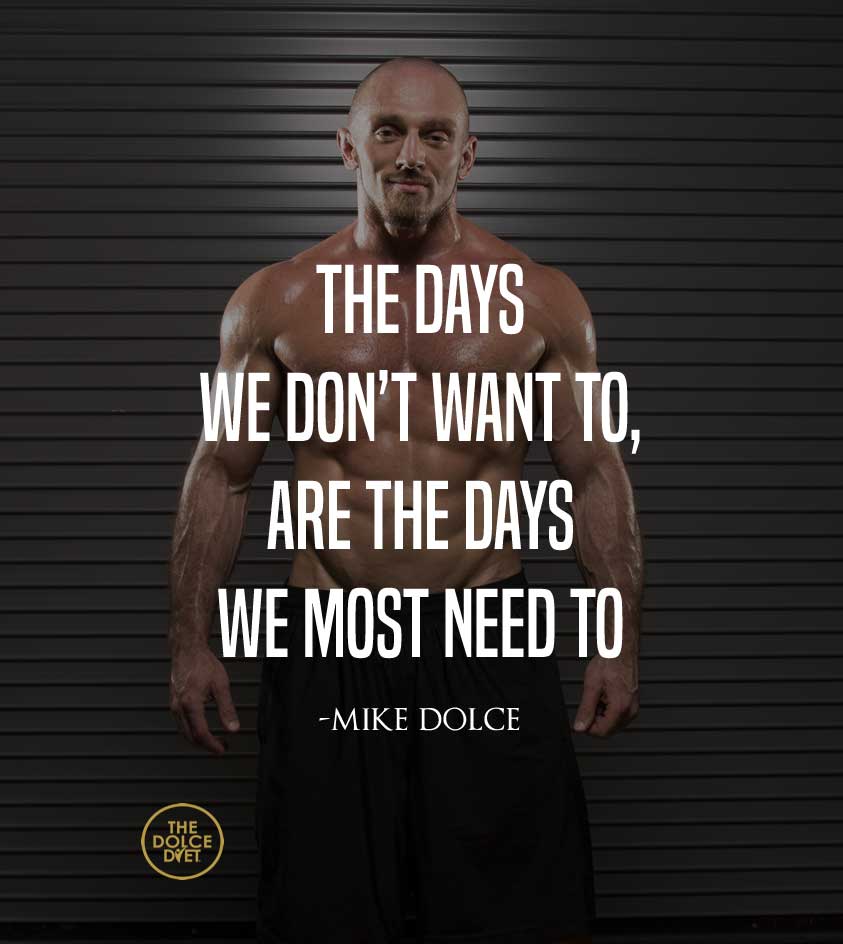Wrestling the Scale: A Call for Action in the Sport of Wrestling
By Ridge Kiley, CSCS, Former D1 Wrester
 Wrestlers are the greatest athletes on the planet with the worst diets. To be successful, wrestlers need strength, speed, flexibility, endurance, agility and power, all of which are negatively affected by the caloric restriction and dehydration incurred during a typical weight cut.
Wrestlers are the greatest athletes on the planet with the worst diets. To be successful, wrestlers need strength, speed, flexibility, endurance, agility and power, all of which are negatively affected by the caloric restriction and dehydration incurred during a typical weight cut.
I have personally seen weight cutting ruin wrestling careers. Teammates and friends of mine have quit, hated the sport, lost interest, or became injured all from the root cause of weight cutting (though not all injuries are caused by dehydration). I personally have been so dehydrated and malnourished that stepping in front of a car sounded like a good idea, so I could eat and drink without repercussions from coaches. I know I’m not the only one that has felt this way.
Weight cutting has been around in combat sports for many, many years. The common perceived advantages of cutting weight is that it allows you to be bigger, faster and stronger than your opponent. But at what point does a perceived advantage become a disadvantage? With the current certification and weigh-in protocols for high school and collegiate wrestling, athletes aren’t able to find success with short-term rapid weight loss.
Often, wrestlers are pressured by coaches, parents or teammates to obtain a lower weight class in pursuit of greater success. While the team may benefit overall, the athlete usually competes at suboptimal levels. Ideally, male athletes would compete at body fat ranges from 7%-12%, and most optimally between 7% and 9%. Ideal body fat levels for female combat sport athletes range from 16% to 20%. The most successful male combat athletes on the planet, (Olympic athletes), have been shown to compete between 6.9% and 7.9% body fat. Unfortunately, individuals practicing weight cutting often fall victim to one of two things:
1) They don’t achieve optimal body weight and body fat before the season starts
OR
2) Athletes are at or below an optimal body weight and body fat, and continue to lose weight through calorie and fluid restriction
Athletes choosing to use harsh weight cutting methods end up throwing away all the hard work (strength and endurance gains) they invested in the off-season. Unfortunately, small guys get the short(er) end of the stick. Weight classes are spread out, which puts certain guys in “limbo” – stuck between weight classes – too small for one, maybe too big for another.
Additionally, small guys end up having to lose a greater percentage of body weight compared to bigger guys. Ten pounds on a 125-pounder is NOT the same as 10 lbs. on a 197-pounder (8% of body weight compared to 5%). Although each person will react differently to the effects of dehydration, research consistently shows that as dehydration levels increase, performance dramatically decreases and risk for injury increases.
Dehydration & Physical Performance
The negative effects of dehydration start at just 2%, which include: decreased muscle strength, decreased endurance, decreased coordination, increased core temperature, increased heart rate, increased perceived exertion (RPE), increased glycogen (carbohydrate) usage, altered metabolic function, decreased mental acuity, altered central nervous system function, reduction in blood volume, decreased skin blood flow, decreased sweat rate, decreased heat dissipation, central nervous system dysfunction, and cardiovascular strain. Sounds like a lot right? Athletes losing up to 5% body weight loss are at an even greater risk for: nausea, cramps, vomiting, fainting, kidney failure, and even death (Jetton et al., 2013; Gann, Tinsley, & La Bounty, 2015; Sawka et al., 2007; Jeukendrup & Gleeson, 2010).
Dehydration & Psychological Performance
Not only does dehydration have negative physical side effects, it can also affect mental performance. As one with personal experience cutting large amounts of weight, I believe there are some (and I use this term loosely) positive psychological benefits from cutting weight. There is an element of prestige, discipline, focus, confidence, and mental toughness one gains from pushing their body to limits they never thought were possible. That being said, an athlete doesn’t have to go through a weight cut to become “mentally tough” – that’s what grueling practices are for.
Research has shown weight cutting negatively affects mood and contributes to feelings of fatigue, anger, anxiety, tension, and confusion. Dehydration is shown to cause a 23% decrease in motivation and a 70% increase in fatigue compared to being in a hydrated state. It has also shown to disrupt short-term memory, attention, arithmetic ability, and response time (Lieberman, 2007 & Kalman and Lepeley, 2010 & Grandjean and Grandjean, 2006). Cutting weight can also impact eating behaviors and in extreme cases lead to disordered eating (binge eating, purging, etc.) (Gann et al. 2015; Jones et al., 2008). Are these things you want to be dealing with going into competition?
In the left picture below is me just 4 months after competing at the D1 NCAA Tournament at 133 lbs. In the picture, I weighed about 170 lbs with roughly 7% body fat.

My optimal competition weight should have been 157 lbs (however James Green, returning AA at the time and now current World Bronze medalist was there). Looking back, 165 lbs would have been tough, but I know I would have competed at my absolute best for the whole season. Instead, I was forced to wrestle off at 149 lbs against teammate and friend/stud, Jake Sueflohn. Struggling to make 151 lbs for the wrestle off, I lost both matches, and was faced with a tough decision – go down to 141 lbs or potentially sit on the bench for my 5th and final season. I ended up losing all of the muscle I had worked so hard to put on (picture on the right).
I had the best training of my life that summer – I truly believe I could have (and was going to) obtain All-American status my final year. Long-story short, large amounts of weight cutting ultimately ended in increasingly poor performances throughout the season. Behind the scenes, I felt terrible, had consistently bad practices, and performed poorly. I was always competing against the scale, not against my opponents.
Poor Practices Lead to Poor Habits
The effects of weight cutting go far beyond competition alone. Given most athletes begin “the weight cut” each Monday, this means that athletes are practicing in a nutritionally-compromised/dehydrated state most, if not all, week long. As stated above, this has negative physical effects and strips athletes of the ability to practice at optimal levels. Poor performances during practices result in poor habits. Poor habits are revealed in competition. Subpar performances in practice and competition affect confidence. A wrestler that isn’t confident in their abilities won’t perform well. With those variables, wrestlers might be competing at 40-75% of their optimal state.
The bottom line: current weight cutting methods are outdated. Although unhealthy weight loss isn’t always the intention, it’s almost always the outcome. It’s important to note that just because it works, doesn’t mean it’s the safest, healthiest, or best option. Athletes looking to have an edge over their opponents need to fix two key components of wrestling: nutrition and hydration.
The Future of Wrestling
The “suck it up” and “tough it out” philosophies of weight cutting are no longer necessary. Wrestling is evolving. Don’t believe me? Take a look at these studs that found success in folkstyle from NOT cutting weight. Most of these athletes were/are competing at lean/optimal body weights.
Kyle Dake → 141 → 149 → 157 → 165: 4x NCAA Champion at 4 weight classes
Jordan Burroughs → 149 to 157: National Champion → 157 to 165: National Champion
Kyle Snyder → 197 to heavyweight → National Champion
Nashon Garrett → 125 to 133 → National Champion
Alex Dieringer → 157 to 165 → 2nd & 3rd consecutive titles
Steven Rodrigues → 141 to 165 → All-American
In conclusion, extreme weight cutting is not the path to success in folkstyle wrestling. One or 2-hour weigh-ins do not allow the body to adequately rehydrate and refuel before competition. Instead, optimal performance is obtained through a balanced diet, maintaining a healthier day-to-day weight, and safe/modest fluid manipulation. Moreover, success is achieved through sustainable lifestyle management 365 days a year. The greats of wrestling fall in love with the process and look forward to getting better every single day. Embracing the grind is a must. Having fun is a must. As many reading this know, a season full of large weight cuts is not fun. It creates burnout and hatred towards a sport you once loved.
The Solution
Here at The Dolce Diet, it is our passion to see athletes perform at their peak potential. It is also our passion to see athletes live the healthiest life possible. As one of the most decorated nutrition companies in weight-class sports, we have the tools to help you end the yo-yo dieting cycle, find sustainability and achieve athletic success. In addition to working with MMA’s most elite, we also work closely with high school, collegiate and Olympic level wrestlers. Some of our current clients include teams or individuals from Campbell University, Purdue University, Penn State and Oklahoma State.
We see a huge need for reform in the wrestling community. As a result, we have recently expanded our services to include one-on-one consultations and individual nutrition plans for wrestlers of all ages. If you are looking to take your nutrition to the next level, go to TheDolceDiet.com and schedule a consultation with one of our sports dietitians today.
If you have any questions, feel free to send me a direct message or email me at ridge@thedolcediet.com.






1 reply on “Wrestling the Scale: A Call for Action in the Sport of Wrestling”
Great article Ridge. As a high school coach I preach to my kids the importance of a healthy diet and good workout habits–cutting weight is a no go in my room. If you get there as part of a natural progression that is great, otherwise you wrestle up. As a Nebraska fan, I think we all saw the impact that such a big cut had on you and your ability to become an AA–it would have been great to see what you could have achieved at a healthier weight for you. Keep up the good work and spreading the word.